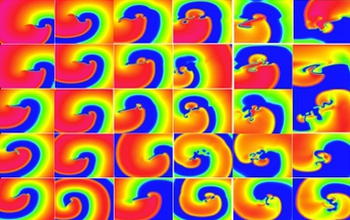All Images
News Release 15-052
Exploring a new frontier of cyber-physical systems: The human body
NSF supports projects to design virtual heart models and robot-cell hybrids
This material is available primarily for archival purposes. Telephone numbers or other contact information may be out of date; please see current contact information at media contacts.
Simulation of electrical impulse propagation through the heart during ventricular fibrillation. Colour represents the transmembrane potential--i.e. the voltage across the cell membrane--on the surface of the heart. Yellow indicates largest potential values while dark red represents resting level. This simulation was performed by Pras Pathmanathan and Richard A. Gray at the US Food and Drug Administration (FDA), using the software package Chaste, together with a high-resolution anatomically-detailed computational mesh of the rabbit ventricles, and was run on FDA's high performance computing resources in the Center for Devices and Radiological Health (CDRH).
Credit: Pras Pathmanathan and Richard A. Gray, US Food and Drug Administration (FDA)
A chemical-carrying polymeric microbead is captured and delivered to the cell body of a neuron using a magnetic microrobot. Control of the microrobot is automated using visual feedback. The microrobot is 35 microns in width.
Credit: E Steager, MS Sakar, C Magee, A Cowley, V Kumar, GRASP Lab, University of Pennsylvania

Simulations of complex spatial patterns indicative of cardiac arrhythmic disorders, including spiral waves and spiral wave breakup.
Credit: CMACS group
Download the high-resolution JPG version of the image. (281.9 KB)
Use your mouse to right-click (Mac users may need to Ctrl-click) the link above and choose the option that will save the file or target to your computer.
Researchers from Boston University developed new algorithms to solve the Vehicle Routing Problem, an important problem in the fields of transportation, distribution, and logistics. The proposed algorithms, which are based on concepts and tools from formal verification and optimization, generate collision-free motion plans automatically from temporal logic statements and vehicle characteristics such as maximum operation time and minimum replenish time. The coordination of multiple micro-robots is critical for the success of the bio-CPS project.
Credit: Cristian Ioan Vasile and Calin Belta, Boston University


